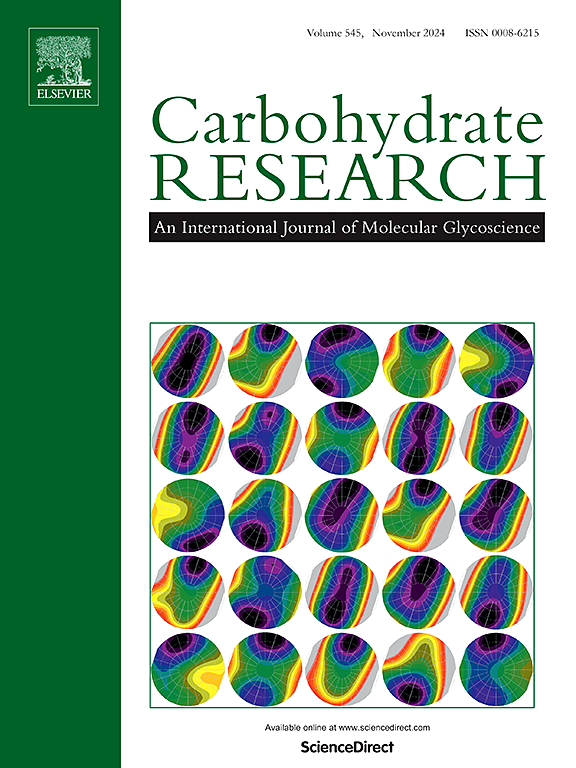Thermo-functional characterization of the carbohydrate-rich fractions of pea (CRFP) as influenced by particle size
IF 2.5
3区 化学
Q3 BIOCHEMISTRY & MOLECULAR BIOLOGY
引用次数: 0
Abstract
This study examined the impact of particle size on the thermal and functional properties of the carbohydrate-rich fraction of pea (CRFP). Four CRFP samples were analyzed: >32<53 μm, >53<75 μm, >75 μm, and a whole fraction (control). The investigation focused on physical, thermal, pasting, functional, amylose, amylopectin, and retrogradation properties. The >75 μm fraction displayed a bimodal particle size distribution, while the others had a single mode. The >32 < 53 μm CRFP fraction had least initiation temperature (Ti = 45.82 ± 1.1 °C), concluding temperature (Tc = 59.22 ± 0.9 °C), enthalpy (ΔH = 2.94 ± 0.3 j/g) and gelatinization temperature range (ΔT = 20.90 ± 1.2 °C). Pasting temperatures showed no significant differences (P < 0.05), though the >75 μm fraction did not paste. Amylose content was highest in the finest fraction (>32 < 53 μm) and lowest in the coarsest fraction (>75 μm). Swelling capacity increased with particle size. All samples showed similar crystalline patterns characteristic of C-type starches, with the coarsest fraction displaying an additional crystalline peak. Raman spectroscopy revealed consistent structural features across all fractions. Overall, the particle size of CRFP influenced its thermo-functional properties, offering a promising approach for its industrial applications.

豌豆富含碳水化合物组分(CRFP)的热功能表征受颗粒大小的影响
本研究考察了颗粒大小对豌豆富含碳水化合物部分(CRFP)热性能和功能特性的影响。分析了四种CRFP样品:>;32<53 μm, >53<75 μm, >;75 μm和整分数(对照)。研究的重点是物理、热、糊化、功能、直链淀粉、支链淀粉和退化性质。75 μm颗粒呈双峰型分布,其余颗粒呈单峰型分布。>32 <;53 μm CRFP分数的起始温度(Ti = 45.82±1.1℃)最小,温度(Tc = 59.22±0.9℃)最小,焓(ΔH = 2.94±0.3 j/g)最小,糊化温度范围(ΔT = 20.90±1.2℃)最小。粘贴温度无显著差异(P <;0.05),但>;75 μm的分数没有粘贴。直链淀粉含量最高的是细粒(>32 <;53 μm),最粗段(>75 μm)最小。膨胀容量随粒径的增大而增大。所有样品都显示出与c型淀粉相似的结晶模式,最粗的部分显示出额外的结晶峰。拉曼光谱显示所有馏分的结构特征一致。综上所述,CRFP的颗粒大小影响其热功能性能,为其工业应用提供了一个有前景的途径。
本文章由计算机程序翻译,如有差异,请以英文原文为准。
求助全文
约1分钟内获得全文
求助全文
来源期刊

Carbohydrate Research
化学-生化与分子生物学
CiteScore
5.00
自引率
3.20%
发文量
183
审稿时长
3.6 weeks
期刊介绍:
Carbohydrate Research publishes reports of original research in the following areas of carbohydrate science: action of enzymes, analytical chemistry, biochemistry (biosynthesis, degradation, structural and functional biochemistry, conformation, molecular recognition, enzyme mechanisms, carbohydrate-processing enzymes, including glycosidases and glycosyltransferases), chemical synthesis, isolation of natural products, physicochemical studies, reactions and their mechanisms, the study of structures and stereochemistry, and technological aspects.
Papers on polysaccharides should have a "molecular" component; that is a paper on new or modified polysaccharides should include structural information and characterization in addition to the usual studies of rheological properties and the like. A paper on a new, naturally occurring polysaccharide should include structural information, defining monosaccharide components and linkage sequence.
Papers devoted wholly or partly to X-ray crystallographic studies, or to computational aspects (molecular mechanics or molecular orbital calculations, simulations via molecular dynamics), will be considered if they meet certain criteria. For computational papers the requirements are that the methods used be specified in sufficient detail to permit replication of the results, and that the conclusions be shown to have relevance to experimental observations - the authors'' own data or data from the literature. Specific directions for the presentation of X-ray data are given below under Results and "discussion".
 求助内容:
求助内容: 应助结果提醒方式:
应助结果提醒方式:


